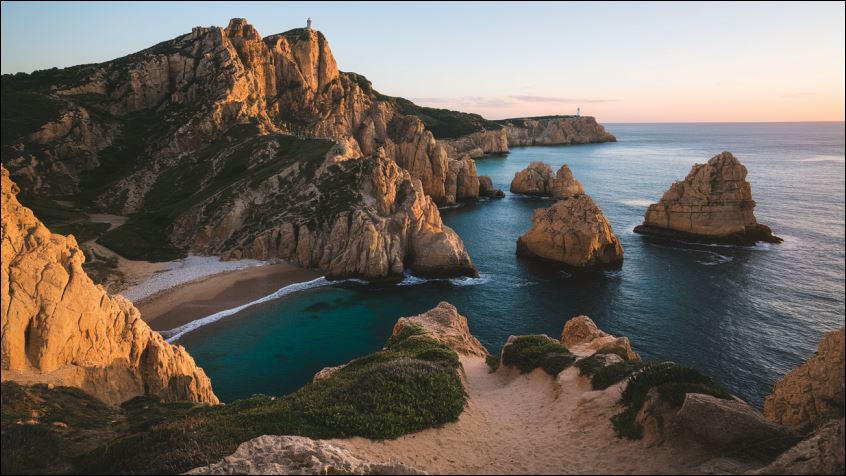Ever felt that rush when you’re standing at the edge of a cliff, waves crashing below, and all of Portugal’s wild beauty spread before you? That’s not just adrenaline – that’s your soul waking up.
Portugal’s natural wonders aren’t just pretty Instagram backdrops. They’re living, breathing playgrounds waiting for your footprints, paddle strokes, and “holy crap that was amazing” moments.
From kayaking through limestone caves in the Algarve to hiking ancient trails in Peneda-Gerês, Portugal’s outdoor adventures offer experiences that’ll make your friends’ beach selfies look painfully boring.
But here’s what nobody tells you about these Portuguese landscapes until you’re face-to-face with them…
Discovering Portugal’s Coastal Treasures
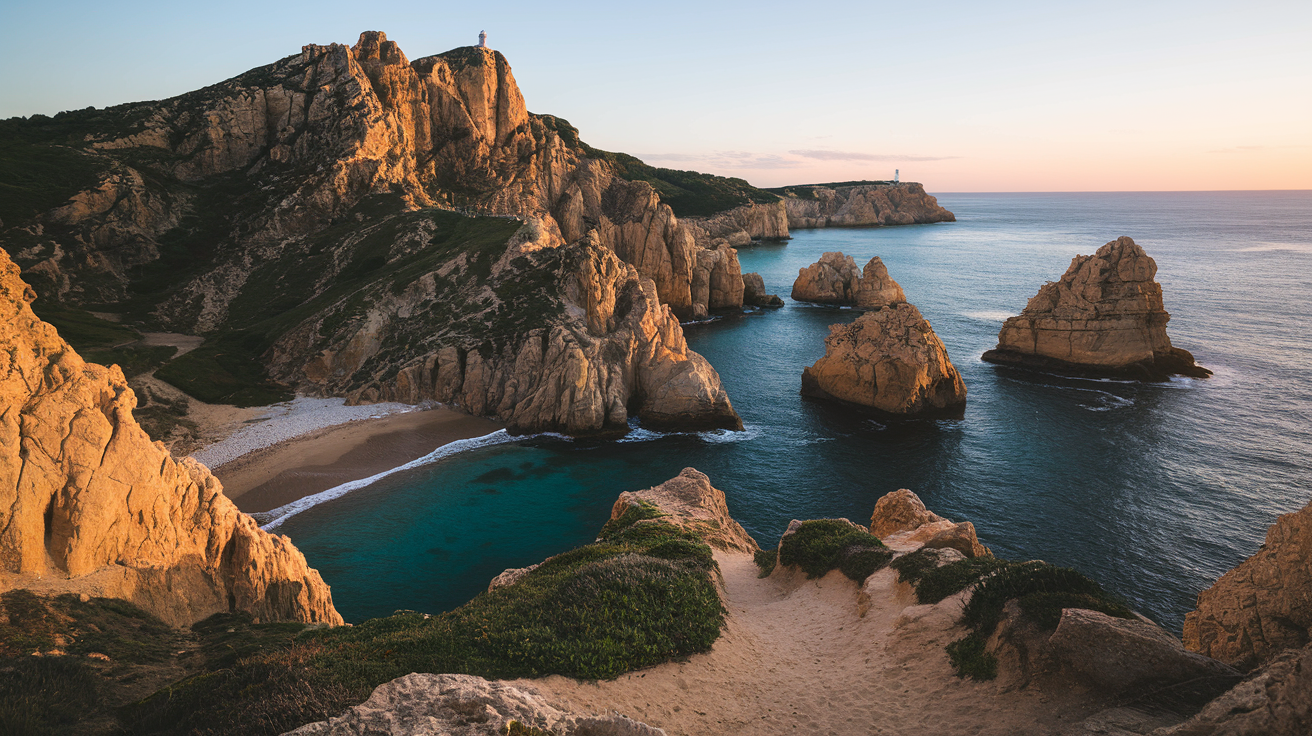
Surfing World-Class Waves in Nazaré
Portugal’s crown jewel of surf spots isn’t just famous—it’s legendary. Nazaré has smashed world records with waves that tower up to 100 feet high. This isn’t your average beach day, folks.
The magic happens thanks to the Nazaré Canyon, an underwater trench that’s deeper than the Grand Canyon. When winter swells hit this geological marvel, they transform into monsters that draw the world’s bravest surfers.
Remember Garrett McNamara’s viral 78-foot wave back in 2011? That put this sleepy fishing village on the map. Now each winter, the cliffs at Praia do Norte fill with spectators clutching their phones, ready to capture the next jaw-dropping ride.
But here’s what most tourists miss—you don’t need to be a pro to experience Nazaré’s surf culture. During summer months, the south beach offers gentler waves perfect for beginners. Several local surf schools will get you standing on a board within a day.
The best time to witness the giants? November through March. Just head to the iconic red lighthouse for the perfect viewpoint. The locals will tell you stories of ancient legends that once blamed these massive waves on supernatural forces—and standing there watching them crash, you might just believe it too.
Kayaking Through Benagil Sea Caves
The Benagil Cave isn’t just Portugal’s most photographed sea cave—it’s a natural cathedral that puts most human architecture to shame. And trust me, kayaking through its entrance beats any Instagram photo you’ve seen.
Located near Lagoa in the Algarve, this dome-shaped marvel features a perfect circular opening at the top (locals call it “the eye”) that creates a natural skylight. When sunbeams pierce through, they illuminate the golden sand beach inside with an otherworldly glow.
Summer mornings are prime time for kayaking here. The water is calmer, the light is perfect, and you’ll beat the afternoon tour boat crowds. Plenty of operators in nearby Benagil Beach rent kayaks or offer guided tours for around €30-40.
What nobody tells you about kayaking Benagil: it’s just one of dozens of sea caves along this stretch of coast. A good 3-hour kayak tour will take you through at least 15-20 different formations, each with its own quirky shape and character.
The paddling itself is moderate—suitable for beginners with basic fitness levels. The distance from Benagil Beach to the main cave is just about 200 meters, but most tours cover about 2-3km of coastline.
Water temperature is surprisingly comfortable from June through October, hovering around 20°C (68°F). But pack a water-resistant bag for your phone—you’ll want photos inside these geological wonders.
Cliff Jumping at Algarve’s Hidden Coves
The Algarve coastline hides dozens of secret jumping spots that only locals know about. These aren’t your typical tourist attractions—they’re raw, thrilling, and completely unforgettable.
Ponta da Piedade near Lagos offers natural rock platforms ranging from tame 3-meter jumps to heart-pounding 12-meter plunges. The water below is crystal clear and deep blue, so you can actually see just how deep it is (usually 5-8 meters).
Safety first, though. The best approach is befriending locals or joining one of the coasteering tours that combine swimming, climbing, and jumping. These guides know exactly which spots are safe based on tides and recent weather.
Praia do Camilo hides a little-known jumping rock just around its eastern headland. It’s accessible only by swimming or kayaking around the point, which keeps the crowds thin even in peak summer.
For the true adrenaline junkies, Praia da Marinha has a famous arch formation with a challenging 10-meter jump that’s become something of a rite of passage among adventure travelers. The trick is timing your jump with the incoming swells—something you should only attempt with experienced locals.
The water temperature in these coves stays comfortable from May through October. Even better, the limestone cliffs warm up in the afternoon sun, creating perfect conditions for spending hours exploring and jumping.
Many first-timers are surprised to learn that cliff jumping has been a local tradition for generations. Algarve fishermen would use these jumps as shortcuts to reach difficult fishing spots. Now it’s your turn to follow in their footsteps.
Coastal Hiking Along the Fisherman’s Trail
The Fisherman’s Trail isn’t just another coastal hike—it’s Portugal’s wild side in its purest form. This 120km trail follows ancient paths that local fishermen used for centuries to reach the best fishing spots along the rugged Alentejo coast.
The most spectacular section runs from Porto Covo to Odeceixe, covering about 75km of untamed shoreline. Unlike most popular European trails, you won’t find crowds here—just endless clifftop views, secret beaches, and the constant rhythm of Atlantic waves.
What makes this trail special is how it balances difficulty with accessibility. The walking itself isn’t technically challenging, but the constant up and down along sandy paths and the exposure to elements demands respect. You’ll need good hiking shoes and plenty of water—there are stretches of 5-6 hours without resupply points.
Spring (April-May) delivers an unexpected bonus: wildflowers transform the clifftops into carpets of color. Pinks, yellows, and purples stretch as far as you can see, creating a stark contrast against the deep blue ocean below.
Wildlife spotting adds another dimension to the hike. Storks nest on impossible-looking cliff edges, dolphins often play in the waves below, and if you’re hiking between December and March, you might spot migrating whales.
The fishing villages along the route offer perfect overnight stops. Places like Zambujeira do Mar and Almograve provide simple but comfortable accommodations and seafood that goes straight from boat to plate.
Most hikers tackle the trail in 4-5 days, though you can easily extend this by adding rest days at the most beautiful beaches. Vila Nova de Milfontes marks a natural midpoint and offers the most amenities if you need a break from the wild.
The trail is well-marked with blue and green stripes, but downloading the official app provides GPS tracks and highlights points of interest. Cell coverage is surprisingly good along most of the route.
This isn’t a trail for those seeking luxury. It’s for people who want to experience Portugal as it was centuries ago—raw, powerful, and profoundly beautiful in its simplicity.
Mountain Adventures in Serra da Estrela

Skiing Portugal’s Only Winter Resort
Ever told someone you’re hitting the slopes in Portugal and watched their face scrunch up in confusion?
Yeah, that’s the usual reaction.
Most folks picture Portugal as all beaches and vineyards—not exactly a winter sports paradise. But tucked away in the Serra da Estrela mountains sits a little secret: Portugal’s one and only ski resort.
The resort might be modest compared to the Alps giants, but what it lacks in size, it makes up for in uniqueness. Where else can you ski in the morning and potentially hit the beach that same afternoon? Only in Portugal, my friends.
The ski area spans about 9 kilometers of slopes, with four lifts serving a variety of runs suitable for beginners to intermediate skiers. The highest point reaches nearly 2,000 meters, offering some surprisingly good powder days when conditions align.
The best time to visit? January through March delivers the most reliable snow conditions. But here’s a pro tip: weekdays are magical here. The weekend crowds from Lisbon and Porto disappear, and you’ll sometimes feel like you’ve rented the entire mountain for yourself.
Equipment rentals won’t break the bank either. A full day setup including skis, boots, and poles runs about €25-30, making this one of Europe’s more affordable ski experiences.
What makes Serra da Estrela skiing truly special isn’t world-class infrastructure—it’s the surreal experience of carving turns while gazing out at distinctly Portuguese landscapes. On clear days, the views stretch for miles across rolling hills dotted with traditional stone villages.
If you’re bringing the kids, the resort has a dedicated snow park where they can sled and play. There’s something oddly satisfying about building a snowman in a country famous for its beaches.
The après-ski scene? Don’t expect St. Moritz, but the mountain restaurants serve hearty Portuguese mountain cuisine that hits differently after a day on the slopes. Think caldo verde (kale soup) and Serra da Estrela cheese—one of Portugal’s culinary treasures produced right in these mountains.
Rock Climbing Granite Formations
The granite playground of Serra da Estrela doesn’t shut down when the snow melts. In fact, that’s when the vertical adventure really begins.
These ancient granite formations have been sculpted by ice, wind, and time into a climber’s paradise that somehow still flies under the radar internationally. Good news for you—fewer crowds, more rock.
The climbing here offers something for everyone. Complete newbie? The Torre sector has plenty of single-pitch routes rated between 4 and 6a (French grading). Looking to test yourself? Head to the Covão do Boi area where challenging overhangs and technical face climbs reach up to 8b.
What makes these granite formations special is their texture—coarse enough to provide excellent friction but not so rough that your hands get shredded after a day of climbing. The rock features natural pockets, cracks, and slabs that create diverse climbing problems requiring everything from delicate footwork to powerful dynos.
One standout area is Penhas Douradas, where dozens of boulders scatter the landscape like a giant’s playground. The bouldering here is world-class, with problems ranging from easy warm-ups to projects that will keep you coming back year after year.
Traditional climbing enthusiasts will find their happy place at the Cântaro Magro formation. This 300-meter wall offers multi-pitch routes with natural protection possibilities and the kind of exposure that makes your heart race and your Instagram followers jealous.
Unlike crowded climbing destinations elsewhere in Europe, you’ll rarely need to queue for routes here. Even during peak season (April-October), you might have entire sectors to yourself on weekdays.
The approach hikes are part of the adventure, taking you through landscapes that shift between alpine meadows, giant boulder fields, and fragrant pine forests. Keep your eyes peeled for the Serra da Estrela Mountain Dog—these gentle giants have historically protected sheep flocks in these mountains and are now a beloved Portuguese breed.
Pack plenty of water and sunscreen though. The mountain weather can be deceptive—cool air temperatures often mask the intensity of the sun at altitude. Many a climber has learned this lesson the hard way, sporting the distinctive “climber’s burn” (red arms, neck, and face) the next day.
Local climbing guides can show you the best spots if you’re unfamiliar with the area. A full day with a guide runs about €70-100 per person and includes all necessary equipment. For the self-sufficient climber, the newly published Serra da Estrela climbing guidebook maps over 500 routes throughout the region.
Mountain Biking Through Ancient Trails
The network of trails crisscrossing Serra da Estrela tells a story thousands of years in the making. Ancient shepherds carved these paths, Roman traders expanded them, and now, mountain bikers are discovering them as Portugal’s best-kept MTB secret.
These aren’t your purpose-built bike park trails with predictable berms and jumps. No, this is raw, natural mountain biking across landscapes that shift dramatically as you change elevation. One minute you’re navigating granite-strewn alpine terrain, the next you’re flowing through pine forests on loamy soil that feels like riding on velvet.
The diversity is mind-blowing. The upper mountain sections offer technical rock gardens that will test even advanced riders. Drop a few hundred meters in elevation and you’ll find yourself on flowing singletrack through heather and juniper bushes that release their scent as your tires brush past.
The crown jewel for enduro fans is the “Glacier Route”—a 20km descent that starts near Torre (the highest point) and drops nearly 1,000 meters of elevation. The trail follows ancient glacial valleys, offering everything from fast, open sections to technical rock features. The best part? The views of the U-shaped valleys carved by ice age glaciers provide a geography lesson you’ll never forget.
Cross-country riders haven’t been forgotten. The plateau areas offer less technical terrain with rolling trails connecting traditional mountain villages. The “Shepherds’ Circuit” links several stone villages where time seems to have stopped centuries ago. Don’t be surprised if you need to give way to actual shepherds with their flocks—they still use these trails for their original purpose.
Unlike many European mountain destinations, Serra da Estrela offers year-round riding possibilities. Summer brings perfect conditions in the higher elevations where cool mountain air makes riding comfortable even in July and August. Fall paints the landscapes in spectacular colors, while spring carpets the lower slopes with wildflowers.
Winter riding is possible on the lower trails, and the contrast of potentially riding through green valleys while looking up at snow-capped peaks creates a surreal experience you won’t find in many places.
Navigation used to be tricky, but several local companies now offer GPS tracks and even guided tours. A guided day with bike rental runs about €60-80 and is worth every cent for the local knowledge alone. Your guide will likely show you secret trails that don’t appear on any maps and point out the best spots to sample regional specialties like cherry liqueur and the famous Serra cheese.
The mountain bike infrastructure continues to develop, with several bike-friendly accommodations popping up in villages like Manteigas, Gouveia, and Loriga. These small hotels and guesthouses often offer secure bike storage, basic tools for maintenance, and packed lunches designed for riders.
The beauty of mountain biking in Serra da Estrela isn’t just the quality of the trails—it’s how they connect you to a mountain culture that has existed for centuries. You’ll pedal past ancient stone shepherds’ shelters, medieval bridges, and through villages where elderly locals still bake bread in communal stone ovens.
Exploring Azores Archipelago’s Volcanic Wonders

Hiking to Lagoa do Fogo Crater Lake
Picture this: you’re standing at the edge of a massive volcanic crater, gazing down at a pristine azure lake surrounded by verdant slopes and dramatic cliffs. That’s Lagoa do Fogo (Fire Lake) for you – arguably the Azores’ most jaw-dropping natural wonder.
Located in the heart of São Miguel Island, this crater lake sits within a natural reserve at 575 meters above sea level. The hike to reach this hidden gem takes about 2 hours each way, but trust me, every step is worth it.
The trail begins at a small parking area along the regional road. From the moment you start walking, you’re surrounded by endemic Azorean flora – laurel forests, heather, and juniper bushes that cling to the volcanic soil. The scent of wild herbs fills the air as you climb.
What makes this hike special isn’t just the destination but the journey itself. About halfway up, you’ll reach viewpoints that offer sneak peeks of what’s to come. The landscape changes constantly – one minute you’re in dense forest, the next you’re crossing open fields dotted with grazing cattle.
The final approach is where the magic happens. As you crest the rim of the crater, the lake suddenly appears below you in all its glory. The water shifts between deep blue and emerald green depending on the light, creating a mesmerizing effect that no photo can truly capture.
Pack a picnic and spend some time at the small beach area at the lake’s edge. Swimming is allowed, and there’s nothing quite like cooling off in these crystal-clear volcanic waters after your hike. Just remember to take everything back with you – this is a protected area, and preservation is key.
Best time to visit? Early morning to avoid crowds and catch the mist rising off the water. And always check the weather before you go – the microclimate here can change rapidly, and fog can roll in without warning.
Canyoning Down São Miguel’s Waterfalls
Ready to kick the adrenaline up a notch? Canyoning in São Miguel isn’t just an activity – it’s a full-body immersion into the island’s raw volcanic geography.
The northeast part of the island, particularly around Ribeira dos Caldeirões Natural Park, offers some of the best canyoning routes in Europe. What makes it special? The unique combination of volcanic rock formations, crystal-clear water, and lush Atlantic vegetation creates canyoning courses unlike anywhere else on the planet.
Imagine rappelling down a 30-meter waterfall, the spray creating rainbows around you as you descend. Then sliding down natural rock chutes polished smooth by centuries of flowing water. Next, you’re jumping into deep, emerald pools surrounded by ferns and mosses that give the whole scene a prehistoric feel.
Salto do Cabrito is a favorite route for beginners. This relatively accessible canyon features a series of small waterfalls and jumps that provide thrills without requiring advanced techniques. The water here runs warm thanks to the geothermal activity beneath the surface – a unique twist you won’t find in most canyoning destinations.
For the more experienced, Ribeira dos Caldeirões offers technical routes with higher waterfall rappels, longer swims, and more challenging jumps. The reward? You’ll access spots so remote and untouched that they seem like they’re from another world entirely.
Always go with a local guide. They’ll provide all the necessary equipment (wetsuits, helmets, harnesses) and, more importantly, their knowledge of safe routes and water levels is invaluable. The volcanic terrain here can be unpredictable, and conditions change seasonally.
The best part about canyoning here is the contrast – one minute you’re in an intense, physical challenge; the next, you’re floating in a serene pool surrounded by endemic plants that exist nowhere else on Earth.
Whale Watching in Protected Waters
The Azores sit right in the migration path of over 20 cetacean species, making it one of the world’s premier whale-watching destinations. But what sets it apart is how the activity is managed – with conservation taking center stage.
The waters surrounding the archipelago serve as feeding and breeding grounds for resident and migratory species alike. Sperm whales are the stars of the show – these massive creatures (the largest toothed predators on Earth) can be spotted year-round. Their distinctive blow makes them relatively easy to identify even from a distance.
But it’s not just sperm whales. Depending on when you visit, you might encounter blue whales (spring), sei whales (summer), or even killer orcas. Dolphin species are abundant too – common dolphins, bottlenose dolphins, and the playful Risso’s dolphins frequently accompany boats, seeming to enjoy the interaction.
What makes the Azores special for whale watching is the infrastructure. Local operators use a network of land-based lookouts (vigias) that were originally built for the whaling industry but now serve conservation. These spotters scan the horizon with powerful binoculars and radio sightings to boats, minimizing search time and fuel use while maximizing your chances of encounters.
Tours typically last 3-4 hours and depart from several points around São Miguel. Ponta Delgada offers the most options, but Villafranca do Campo on the south coast provides some of the most reliable sightings.
The regulations here are strict – boats must maintain specific distances, limit viewing time, and approach animals from particular angles to minimize disturbance. It might seem restrictive, but these rules ensure the activity remains sustainable for generations to come.
Pro tip: Choose a company that includes a marine biologist on board. Their insights transform a simple sighting into an educational experience about these magnificent creatures and the challenges they face in our changing oceans.
Hot Spring Bathing in Terra Nostra Gardens
The Terra Nostra Gardens aren’t just any botanical park – they’re a 200-year-old testament to human creativity working in harmony with volcanic forces.
Located in Furnas Valley, the centerpiece of these gardens is the iconic iron-rich thermal pool. The water maintains a constant temperature between 35-40°C (95-104°F), perfect for soothing tired muscles after hiking or canyoning adventures. The rich mineral content gives the water its distinctive golden-brown color – don’t worry about the tint, but do wear an old swimsuit as the iron can temporarily stain light fabrics.
The sensation of slipping into these waters is unlike any regular hot spring. The high mineral content creates a silky feeling on your skin, and many visitors report therapeutic effects on joint pain and skin conditions. The pool is large enough that you can find your own space even on busier days, and the backdrop of exotic plants and volcanic steam vents creates an almost mystical atmosphere.
After your soak, explore the gardens themselves. Created in the 18th century by Thomas Hickling, an American consul, the grounds have expanded to include over 2,000 tree species from around the world. The collection of cycads and endemic Azorean plants is particularly impressive.
Don’t miss the serpentine “Water Garden” section, where a series of small thermal streams create microhabitats for various plant species. The contrast between the manicured European-style formal gardens and the almost jungle-like areas showcasing tropical species reflects the Azores’ unique position at the crossroads of continents.
For the full experience, time your visit to include lunch at the Terra Nostra Hotel restaurant, where you can try “cozido das Furnas” – a traditional stew cooked underground using natural volcanic heat. The meat and vegetables are placed in sealed pots and buried in the hot ground for 6-7 hours, resulting in incredibly tender, flavorful dishes that capture the essence of volcanic cuisine.
Paragliding Over Volcanic Landscapes
Want to see the Azores from a truly unique perspective? Paragliding over São Miguel offers views that even the best hiking trails can’t match.
The island’s varied topography creates ideal conditions for paragliding, with reliable thermal updrafts and launch sites that cater to different experience levels. The most popular spot is the north coast near Nordeste, where pilots can ride the updrafts created when ocean breezes hit the coastal cliffs.
For beginners, tandem flights with experienced pilots offer a safe introduction to the sport. These typically last 15-30 minutes and provide spectacular views of the coastline, crater lakes, and the patchwork of fields and forests that make up the island’s interior.
What makes paragliding here special is the constantly changing landscape beneath you. In a single flight, you might soar over deep blue ocean waters, vibrant green crater lakes, steaming fumaroles, and the distinct patchwork of stone-walled fields that have remained unchanged for centuries.
The view of Sete Cidades, with its twin blue and green lakes, is particularly stunning from above. The full caldera becomes visible, helping you understand the massive scale of the volcanic event that created it thousands of years ago. Similarly, paragliding over Lagoa do Fogo offers perspectives that ground-based visitors never experience – the complete symmetry of the crater and the way sunlight plays on the lake’s surface can only be fully appreciated from the air.
Weather conditions are crucial for paragliding, and the Azores’ maritime climate means mornings typically offer the most stable conditions. Local operators monitor conditions carefully and prioritize safety above all else – don’t be disappointed if flights are canceled due to wind or visibility issues.
The best part? The silence. Once airborne, with the glider above you catching thermal currents, the only sounds are the wind and occasionally your own expressions of awe as you drift over some of the most pristine volcanic landscapes on the planet.
Douro Valley’s Natural Splendors
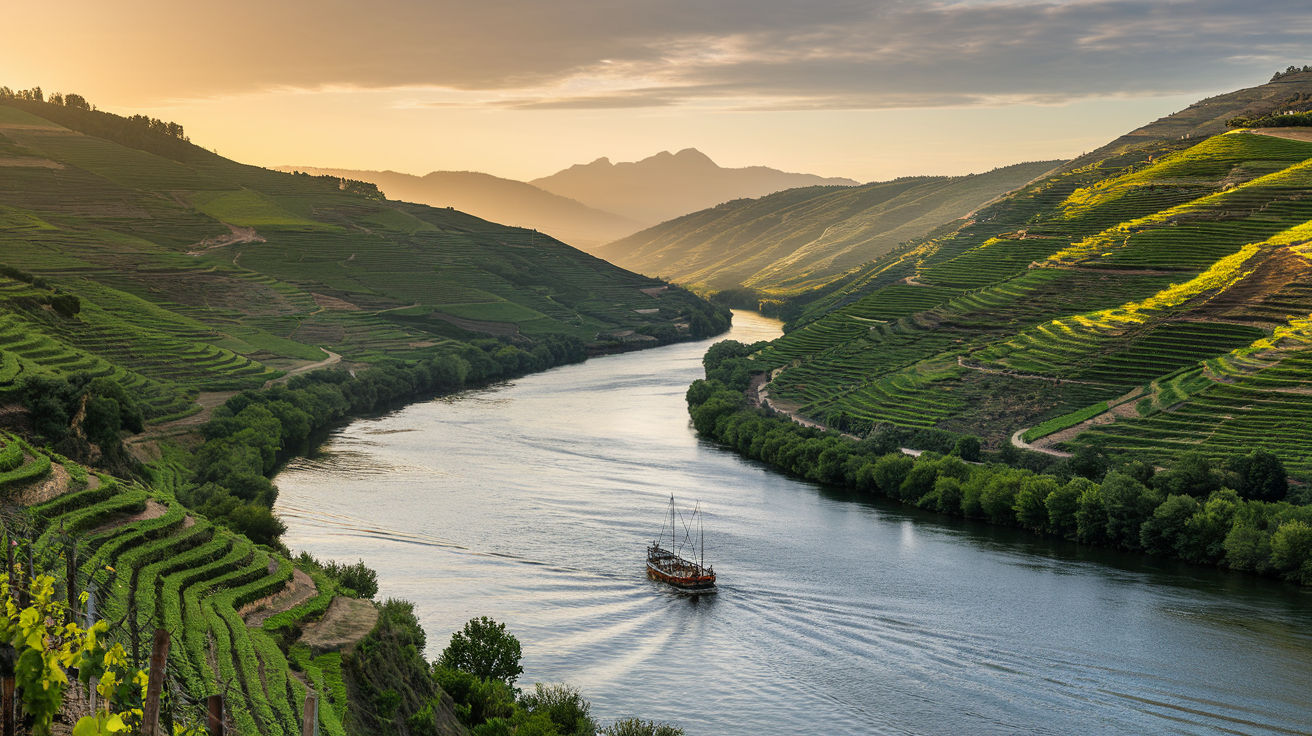
River Rafting Through Wine Country
The Douro Valley isn’t just about sipping port wine and admiring views. It’s got an adventurous side that’ll get your heart racing while surrounding you with jaw-dropping scenery.
Rafting the Douro River is unlike any other water adventure you’ll find in Portugal. Why? Because where else can you paddle through raging rapids with terraced vineyards climbing up steep hillsides all around you?
The river cuts through the heart of wine country, creating a perfect playground for adventure seekers who also appreciate good scenery (and maybe a good glass of wine afterward).
Most rafting trips kick off near Peso da Régua, the unofficial capital of the Douro wine region. The water here alternates between peaceful stretches where you can catch your breath and admire the centuries-old quintas (wine estates) perched on the hillsides, and thrilling rapids that’ll have you gripping your paddle tight.
Spring is prime rafting season. The water levels are higher thanks to the winter rains, making for more exciting rapids. But don’t worry if you’re a beginner – local operators offer trips for all skill levels.
Companies like Douro Rafting Adventures and Portugal Wild Waters provide everything you need: equipment, safety gear, and experienced guides who know the river like the back of their hand. These guides aren’t just there to keep you from tipping over – they’re walking encyclopedias of Douro Valley knowledge, pointing out landmarks and sharing stories about the region’s winemaking history as you paddle.
After a few hours on the water, many tours stop at riverside quintas where you can dry off and sample the very wines you’ve been floating past. There’s something special about tasting a rich Douro red while looking out at the very vines it came from.
For the truly adventurous, overnight rafting trips let you experience the changing moods of the river from dawn till dusk. Camp on the riverbanks under star-filled skies, with the sound of flowing water as your lullaby.
The best part? Rafting gives you access to sections of the valley that are nearly impossible to reach by road. You’ll float past hidden waterfalls, secret beaches, and untouched stretches of nature that most tourists never see.
Hiking Terraced Vineyards
The terraced vineyards of the Douro Valley aren’t just a pretty backdrop for your Instagram photos – they’re a living, breathing testament to human determination. These stone-walled terraces, some dating back to Roman times, transform what would be impossibly steep slopes into productive vineyards.
And there’s no better way to appreciate this UNESCO World Heritage landscape than on foot.
The Douro offers hiking trails for every fitness level, from leisurely strolls through flat vineyard sections to challenging treks that climb high into the surrounding mountains. What unites them all are the absolutely spectacular views.
The N222 route between Pinhão and Régua has been named one of the world’s most beautiful roads, but honestly? The walking paths that crisscross these same hills offer even better perspectives. You’ll find yourself stopping every few minutes just to take it all in.
One of the most popular hiking routes starts in the charming riverside town of Pinhão. From here, well-marked trails lead up through the vineyards of famous port wine producers like Quinta do Bomfim and Quinta das Carvalhas. The climb might make you break a sweat, but the panoramic views from the top are worth every step.
For something a bit more structured, check out the Trilho de São Cristóvão do Douro, a 10km circular route that takes you through vineyards, olive groves, and traditional villages where life moves at a deliciously slow pace.
What makes hiking here special isn’t just the views – it’s the chance to witness the wine-growing process up close. Depending on when you visit, you might see vineyard workers pruning vines, harvesting grapes by hand (yes, many estates still do this the old-fashioned way), or tending to the soil.
The best times for vineyard hiking are spring when the hills are carpeted with wildflowers and the vines show their first green shoots, or September during harvest season when the vineyards buzz with activity and the air smells of ripe grapes.
Many quintas welcome hikers, offering guided tours that combine walking with wine tasting. Quinta do Crasto, perched dramatically on a hilltop, has some of the most breathtaking views in the region and excellent trails through their property.
Don’t forget to pack plenty of water, sun protection, and sturdy shoes – those stone terraces can be uneven underfoot. And while the main paths are well-marked, it’s worth downloading a trail map before setting off.
The reward at the end of your hike? Besides the incredible views and sense of accomplishment, there’s usually a glass of perfectly chilled vinho verde or robust red waiting in one of the valley’s many wine tasting rooms. Your legs might be tired, but your soul will be smiling.
Sailing Scenic River Routes
There’s something almost magical about experiencing the Douro Valley from the water. The reflections of terraced vineyards shimmering on the river’s surface. The silence broken only by the gentle lapping of water against your boat. The way the light plays on the hillsides as the sun moves across the sky.
Traditional wooden rabelo boats once transported barrels of port wine from vineyards to cellars in Vila Nova de Gaia. Today, these flat-bottomed vessels have been repurposed for tourism, offering one of the most authentic ways to experience the Douro’s majesty.
But rabelos aren’t your only option. From luxury cruise ships to intimate sailboats, kayaks to private yacht charters, there’s a floating adventure for every preference and budget.
Day cruises typically depart from Porto, Régua, or Pinhão, taking you through the heart of the valley at a leisurely pace. Multi-day cruises offer a more immersive experience, with stops at riverside towns and wine estates along the way.
What makes sailing the Douro truly special is the perspective it gives you. From the water, you can fully appreciate how the vineyards have been sculpted into the mountainsides, creating a mesmerizing patchwork that changes with the seasons – vibrant green in spring, golden in summer, and a riot of reds and oranges in fall.
The river itself has been tamed by a series of dams and locks, making for smooth sailing while adding an element of engineering interest to your journey. Passing through these massive locks is an experience in itself – your boat enters a concrete chamber that fills or empties with water, raising or lowering your vessel to the next section of river.
For those who prefer a more hands-on experience, sailboat rentals are available from several operators along the river. Nothing compares to the tranquility of cutting through the water under sail power, the only sound the wind in the canvas and perhaps the pop of a cork as you enjoy a picnic lunch onboard.
Early morning and late afternoon offer the most magical light for photography, with the sun casting long shadows across the terraced hills and bathing everything in a golden glow. Sunset cruises are particularly popular, combining sailing with wine tasting as the sky turns pink and orange above the vineyards.
Wildlife enthusiasts should keep their eyes peeled – the Douro Valley is home to over 170 bird species, including majestic birds of prey that soar overhead. If you’re lucky, you might spot otters playing near the shoreline or wild boar coming down to drink at dawn or dusk.
Many boat tours include stops at quintas not accessible by road, offering exclusive wine tasting experiences far from the crowds. Imagine stepping directly from your boat onto a private dock, then being led through ancient vineyards to a tasting room with panoramic views.
The sailing season runs from March through November, though spring and fall offer the most comfortable temperatures and fewer crowds. Summer brings perfect swimming conditions, with warm water temperatures inviting you to take refreshing dips in the river’s cleanest stretches.
Whether you choose a luxury cruise or a simple sailboat rental, seeing the Douro Valley from the water gives you a profound appreciation for this remarkable landscape where nature and human ingenuity have created something truly extraordinary.
Discovering Madeira’s Dramatic Landscapes
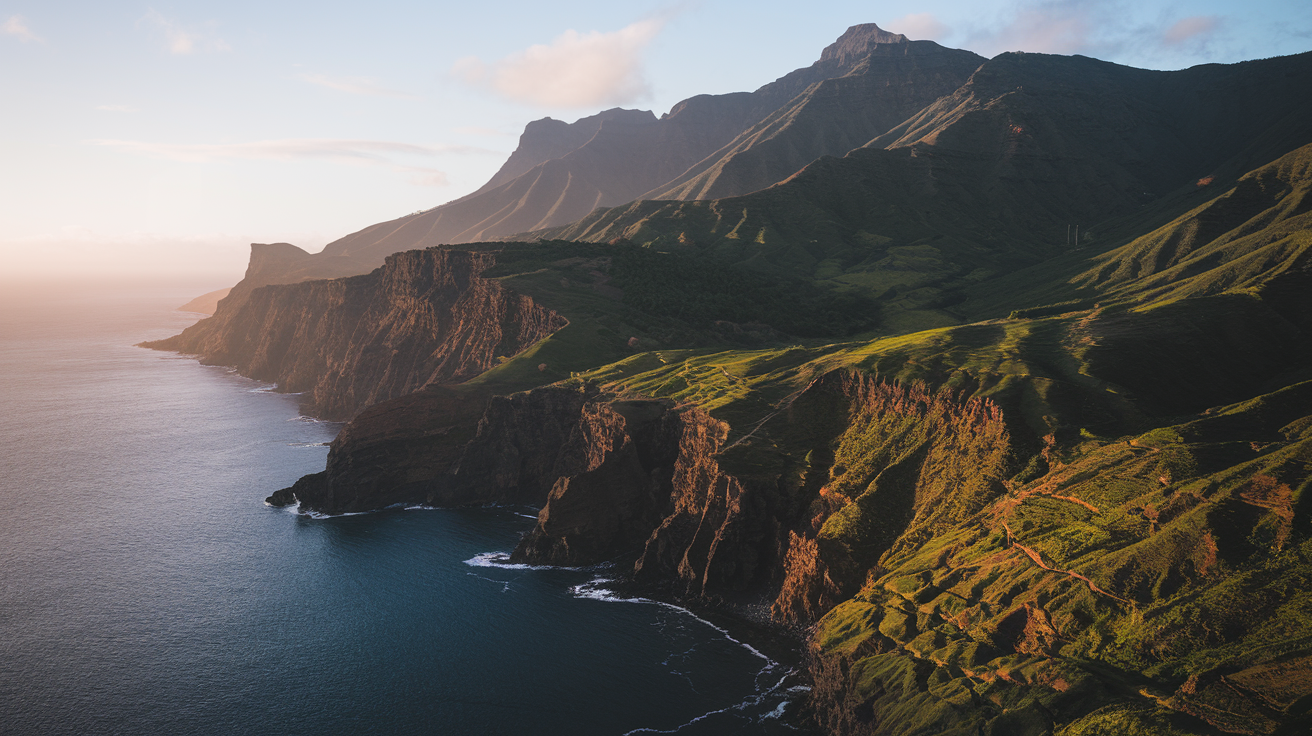
Levada Walking Through Laurisilva Forests
Madeira’s levadas aren’t just irrigation channels – they’re gateways to another world. These narrow canals cut through some of the most breathtaking landscapes you’ll ever lay eyes on, including the ancient Laurisilva forests that blanket much of the island.
Dating back to the 16th century, these engineering marvels were originally built to distribute water from the rainy north to the drier south. Today, they double as hiking paths that give you front-row access to Madeira’s primeval forest – one of the last surviving Laurisilva forests in the world and a UNESCO World Heritage site.
The Laurisilva is magical stuff. Walking through it feels like stepping into a fantasy novel – think moss-draped trees, twisted branches, and an emerald canopy that filters sunlight into dancing patterns on the forest floor. The air is heavy with moisture and the scent of earth and vegetation.
Some of the most stunning levada walks include:
-
Levada do Caldeirão Verde: A 5-hour round trip that takes you through tunnels and past waterfalls to reach the “Green Cauldron” – a natural pool surrounded by vertical cliffs.
-
Levada dos 25 Fontes: Probably the most famous walk on the island, leading to the spectacular “25 Springs” where water cascades down moss-covered rocks.
-
Levada do Rei: Known as the “King’s Levada,” this gentler route offers stunning views without the vertigo-inducing drops of some other trails.
The walks vary in difficulty, but even the easier ones deliver jaw-dropping scenery. You’ll cross narrow bridges, pass through hand-carved tunnels (bring a headlamp!), and walk alongside cliffs with heart-stopping drops. The reward? Vistas that will fill your camera roll and your memory bank.
Canyoning in Pristine Gorges
If walking alongside water isn’t enough of an adrenaline rush, how about jumping, sliding, and rappelling down through it? Madeira’s rugged interior is sliced by deep gorges and ravines that create the perfect playground for canyoning enthusiasts.
Canyoning in Madeira isn’t just about the thrill – though there’s plenty of that. It’s about accessing places so remote and untouched that they’re impossible to reach any other way.
The island offers canyoning routes for all levels:
-
Ribeira das Cales: Perfect for beginners, this canyon offers gentle slides and small jumps in crystal-clear water.
-
Ribeira do Inferno: Living up to its “Hell’s Ravine” name, this intermediate route features higher jumps and more technical rappels.
-
Ribeira dos Cedros: For experienced canyoners only, this challenging route includes a massive 50-meter waterfall rappel that will test your nerve and skill.
What makes Madeira’s canyoning special is the pristine nature of the gorges. You’ll find yourself in narrow volcanic channels where water has carved smooth passages through black basalt. Sunbeams penetrate the gorges at certain times of day, creating ethereal light shows as they hit the cascading water.
The water temperature stays refreshingly cool year-round, making canyoning a perfect activity even in summer. And while you’re focused on the next jump or slide, don’t forget to look around – you might spot endemic plants clinging to the canyon walls or colorful lizards darting between rocks.
Local guides know these canyons inside out and provide all the equipment you’ll need. They’ll also share their knowledge about the island’s geology and ecology, turning an adventure sport into an educational experience. Just be prepared to get completely soaked and come away with a massive grin on your face.
Climbing Pico Ruivo, Madeira’s Highest Peak
Standing tall at 1,862 meters (6,109 feet), Pico Ruivo commands respect as Madeira’s highest point. But here’s the thing about this mountain – you don’t have to be a hardcore mountaineer to conquer it. The well-maintained trails make it accessible to anyone with decent fitness and a pair of sturdy hiking boots.
The most popular route starts at Achada do Teixeira, a relatively easy 5.6 km round trip that takes about 3 hours. But if you’re after a more challenging adventure, try the trail from Pico do Arieiro, Madeira’s third-highest peak. This 11 km ridge walk is widely considered one of Europe’s most spectacular hikes.
The Arieiro to Ruivo trail isn’t for the faint-hearted. It follows a narrow ridge with steep drop-offs on both sides, passes through several tunnels carved into the rock, and includes sections with metal stairs bolted to cliff faces. But man, the views are worth every bead of sweat.
What makes this hike truly special is how quickly the landscape changes. One minute you’re above the clouds in bright sunshine, the next you’re enveloped in swirling mist that transforms the rocky landscape into something otherworldly. The vegetation shifts with altitude too, from lush forests lower down to hardy mountain plants that somehow thrive in this harsh environment.
The summit itself? It’s a revelation. On clear days, you can see the entire island spread out below you – the rugged northern coast, the gentler southern slopes, and the Atlantic stretching to the horizon in every direction. There’s a small shelter at the top where you can catch your breath and soak in the achievement.
Time your hike right, and you might experience one of Madeira’s most magical natural phenomena – the “sea of clouds.” This happens when cloud cover settles below the mountain peaks, creating the illusion that you’re walking above the clouds. It’s the closest most of us will get to feeling like we’re walking on air.
Paragliding Over Flower-Covered Hillsides
Madeira isn’t called the “Floating Garden of the Atlantic” for nothing. The island erupts in color year-round thanks to its subtropical climate and volcanic soil. And what better way to appreciate this floral tapestry than from above?
Paragliding has become increasingly popular on the island, with launch sites offering different perspectives of Madeira’s dramatic landscapes. The thermals created by the island’s mountainous terrain make for excellent flying conditions, with some glides lasting well over an hour.
The most popular takeoff point is at Cabo Girão, near one of Europe’s highest sea cliffs. As you run off the edge (with a qualified instructor if you’re a beginner), the initial stomach drop gives way to an incredible sensation of peaceful floating as the paraglider catches the updrafts.
From your bird’s-eye perspective, Madeira’s patchwork of landscapes unfolds beneath you – terraced agricultural plots, vineyards, banana plantations, and gardens bursting with color. In spring, the hillsides are particularly spectacular, covered in wildflowers and the purple blooms of jacaranda trees.
The flight path typically follows the coastline, giving you unique views of Madeira’s vertiginous cliffs plunging into the deep blue Atlantic. You might spot dolphins playing in the waters below or boats looking like tiny toys from your elevated position.
What’s surprising about paragliding is how quiet and meditative it can be once you’re airborne. The only sounds are the wind and your occasional gasps of delight as you spot another breathtaking view. Your pilot can perform gentle turns and spirals if you’re feeling adventurous, or keep things calm if you prefer a more relaxed experience.
Even if you’ve never considered paragliding before, Madeira is the place to try it. The conditions are ideal, the scenery is unbeatable, and there’s something about seeing the island from above that gives you a deeper appreciation of its volcanic origins and the forces that shaped this Atlantic jewel.
Tandem flights with experienced pilots are available for complete beginners, while certified paragliders can rent equipment and get guidance on the best flying spots. Either way, soaring over Madeira’s flower-covered hillsides and dramatic coastline will likely be one of the most memorable experiences of your visit to this remarkable island.
Wild Camping in Peneda-Gerês National Park
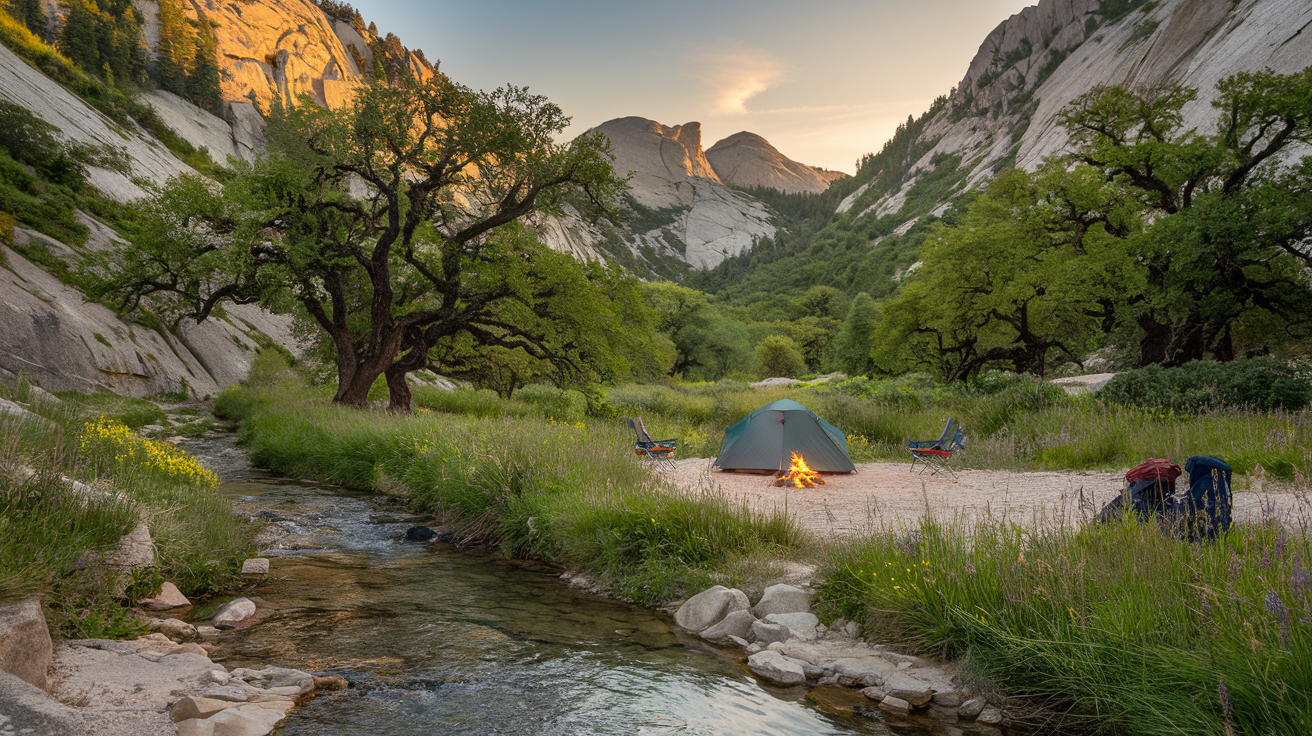
Tracking Iberian Wolves and Wild Horses
Ever camped under a blanket of stars while knowing wild wolves might be padding around nearby? That’s the kind of raw, pulse-quickening experience waiting for you in Peneda-Gerês.
Portugal’s only national park isn’t just gorgeous—it’s home to some of Europe’s most fascinating wildlife. The Iberian wolf, a subspecies that’s both elusive and endangered, roams these mountains. Unlike their larger European cousins, these wolves have adapted to living in closer proximity to humans while somehow remaining almost ghost-like.
Dawn and dusk offer your best shot at spotting them. Head to the park’s northern regions near Castro Laboreiro or Pitões das Júnias where wolf packs are known to hunt. You won’t likely stumble upon them accidentally—and that’s probably for the best—but joining a guided tracking expedition gives you a fighting chance.
These tracking experiences aren’t just about wolf-spotting. The guides know wolf behavior intimately and can point out signs most visitors would walk right past: partially eaten prey, distinctive paw prints, or territorial markings. They’ll teach you to distinguish between wolf and dog tracks (hint: wolf prints are more oval and show the middle toes clearly ahead of the side toes).
The real magic happens when you hear them. A wolf howl echoing through Gerês valleys at dusk? That sound will stick with you forever.
Then there’s the garrano—wild horses that have roamed these mountains since prehistoric times. These small, sturdy creatures with their shaggy manes represent one of Europe’s oldest horse breeds. Unlike the wolves, garranos are relatively easy to spot, especially in the highlands between February and October.
The horses gather in small family groups led by a dominant stallion. They’re technically semi-wild—though they’re free-roaming and mostly fend for themselves, local communities have traditionally maintained loose ownership rights over them.
For the best viewing opportunities, head to the Campo do Gerês plateau or the Serra da Peneda mountains. Early morning offers magical scenes of these horses emerging from the mist, their outlines gradually sharpening against the mountainside.
Pack a decent pair of binoculars (8×42 magnification works well), wear earth-toned clothing, and remember the golden rule of wildlife watching: patience wins the day.
Swimming in Crystal-Clear Mountain Lakes
Nothing feels quite as refreshing as sliding into cool mountain water after a day of hiking.
Peneda-Gerês is dotted with natural swimming spots that look straight out of a fantasy novel. These aren’t your typical overcrowded tourist beaches—they’re secluded, pristine pools nestled among granite boulders and ancient forests.
The Arado Waterfall pools near Gerês village offer one of the most spectacular swimming experiences. The main pool sits at the base of a 30-meter cascade, surrounded by moss-covered rocks. The water is startlingly clear and, yes, startlingly cold—even in summer. But that initial shock gives way to pure refreshment.
For something a little warmer, the Portela do Homem natural pools near the Spanish border are sun-warmed and perfect for longer swims. Several pools of varying depths have formed in the river, connected by small rapids you can use as natural water slides if you’re feeling adventurous.
Perhaps the most magical spot is Lagoa da Peneda. This remote mountain lake sits beneath the imposing Peneda peak, reflecting the surrounding landscape like a mirror on calm days. Getting here requires effort—about a 3-hour hike from the village of Peneda—but you’ll likely have the place entirely to yourself.
My personal favorite? The Fecha de Barjas pools. These secluded swimming holes along the Barjas stream feature emerald-green waters that deepen from shallow paddling spots to jumping pools deep enough for brave divers.
A few hard-earned tips:
- The water temperature rarely climbs above 18°C (64°F), even in August
- Waterproof sandals are essential for navigating slippery rocks
- Morning swims offer the best chance of solitude
- Pack out everything you bring in—these pristine spots stay that way because people respect them
If you’re wild camping nearby, these swimming holes make perfect natural showers. There’s something profoundly satisfying about washing off trail dust in water that fell as rain on these same mountains.
Exploring Medieval Villages
The true soul of Gerês isn’t just in its wilderness but in the ancient stone villages that have stood for centuries among these peaks.
These aren’t museum pieces—they’re living communities where time seems to flow differently. Many follow a layout unchanged since medieval times: clusters of granite houses with distinctive orange-tiled roofs, narrow cobblestone alleys, and community bread ovens where villagers still gather.
Castro Laboreiro sits perched at one of the highest points in the park, with stone houses that blend seamlessly into the rocky landscape. What makes this village unique is its seasonal migration tradition—many families historically maintained two homes, moving between “winter villages” in the valleys and “summer villages” in the highlands.
The community bread ovens (fornos comunitários) here tell a fascinating story of communal living. Families would take turns using these stone ovens, each marked with their household symbol, creating a rotation system that reinforced community bonds.
Soajo might be the most photogenic village, famous for its collection of stone granaries called espigueiros. These raised granite structures were built to store corn safe from moisture and rodents. The 24 granaries of Soajo, perched on a granite outcrop, date back to the 18th and 19th centuries and still stand as a testament to traditional agricultural practices.
For something truly off the beaten path, the semi-abandoned village of Covide offers a glimpse into the past. Many houses stand empty, with nature slowly reclaiming doorways and windows—yet a handful of elderly residents remain, keeping ancient traditions alive.
What makes these villages special isn’t just their architecture but the way traditional life continues. Visit during June’s São João festival or August’s Nossa Senhora da Peneda pilgrimage to see these communities at their most vibrant, with folk music, traditional dances, and feast tables loaded with local specialties like chouriço, broa (cornbread), and homemade wine.
The villages follow the rhythm of seasons rather than clocks. Spring brings terraced fields alive with new plantings, summer sees hay being hand-cut and dried, autumn is marked by grape and chestnut harvests, and winter finds smoke curling from chimneys as families gather around hearths that have warmed generations.
If you’re wild camping in the park, these villages provide perfect resupply points. The small grocery stores (mercearias) might not look like much, but they offer fresh local bread, cheese, and other essentials. Plus, striking up conversations with locals often leads to recommendations for hidden trails and swimming spots you won’t find in any guidebook.
Underground Adventures in Portugal’s Caves
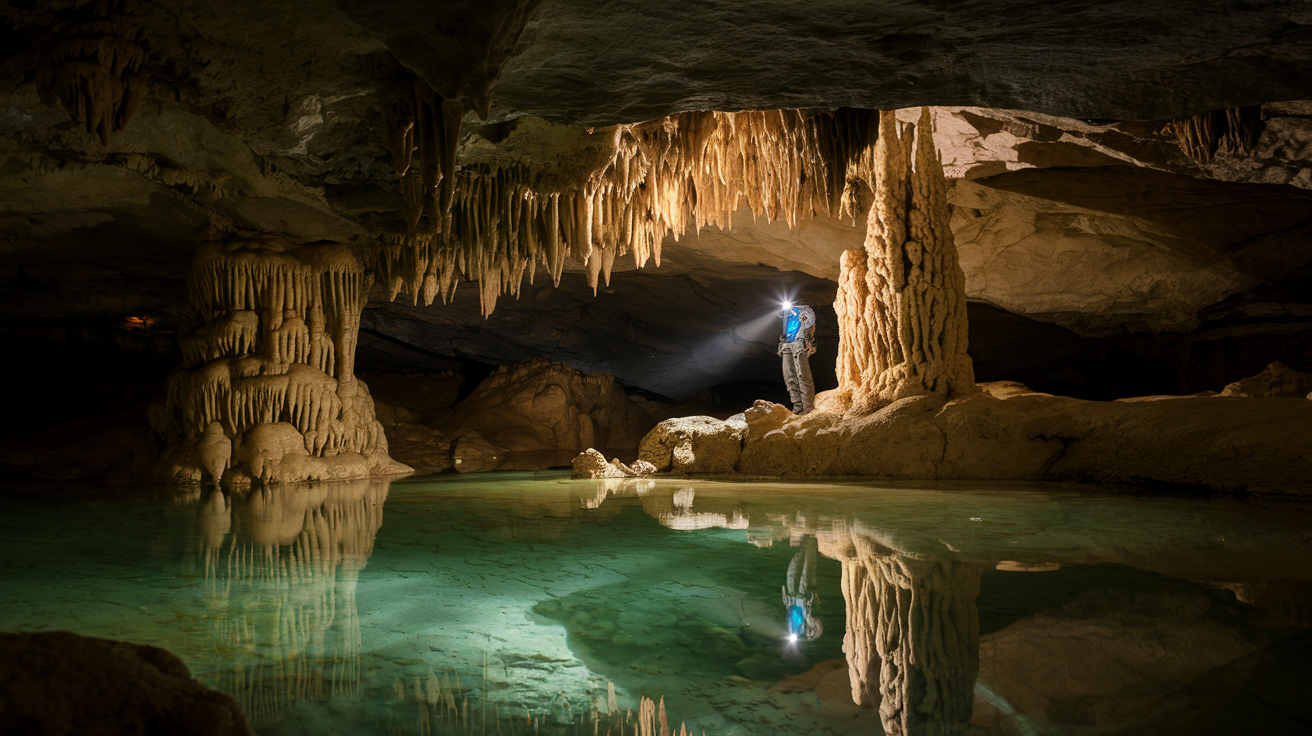
Spelunking Through Mira de Aire Caves
Portugal hides some of its most jaw-dropping wonders beneath your feet. The Mira de Aire Caves top the list as the country’s largest and most spectacular underground system. Discovered by two local hunters chasing a bird in 1947, these caves have transformed from a random find to Portugal’s underground crown jewel.
Drop 110 meters below the surface and you’re in another world. The temperature sits at a steady 17°C (63°F) year-round, making it a perfect escape from summer heat or winter chill. The main chamber stretches nearly 600 meters long, with ceilings soaring 10 meters high.
What makes Mira de Aire unforgettable? The light shows. The carefully placed illumination transforms ordinary stalactites and stalagmites into otherworldly sculptures. The “Rain Room” features a permanent indoor waterfall that’s created a series of terraced pools over thousands of years. The water’s so clear you might not even notice it until you’re right up close.
For newbie spelunkers, Mira de Aire offers guided tours lasting about an hour. They’ve installed proper walkways and handrails, so you don’t need to be a hardcore adventurer to enjoy this underground paradise. The guides know all the best photo spots too—like the “Cathedral,” where massive columns seem to hold up the earth itself.
Want something more adventurous? Book the extended explorer tour where you’ll crawl through narrow passages that most tourists never see. Just bring clothes you don’t mind getting dirty and a sense of adventure.
Pro tip: Visit on weekdays before noon to avoid the crowds. The caves get busy during summer afternoons when tour buses roll in.
Exploring Underground Lakes in Alvados
The Alvados caves might not have the fame of Mira de Aire, but they’ve got something even more magical—hidden underground lakes with water so clear it plays tricks on your eyes.
Discovered in the 1960s, these caves have remained relatively untouched compared to their more commercial cousins. The main attraction here is the series of interconnected crystal-clear lakes that reflect the limestone formations above them, creating perfect mirror images that double the visual impact.
The “Blue Lake” chamber houses the most photographed spot in Alvados. The water contains unique minerals that give it an electric blue glow when lit—no Instagram filter needed. At certain angles, the ceiling reflections make it impossible to tell where the real formations end and their reflections begin.
What sets Alvados apart is the silence. The deeper chambers have perfect acoustics—some guides will demonstrate by singing notes that resonate throughout the cavern. It’s haunting in the best possible way.
The adventure level here kicks up a notch compared to Mira de Aire. Parts of the tour require walking through shallow water (they provide waterproof boots), and some passages are tight enough that you’ll need to duck. Not recommended if you’re claustrophobic, but perfect if you want to feel like a real explorer.
For the truly adventurous, the “Explorer’s Route” takes you off the main path to areas where you’ll need to wade through knee-deep underground streams. The reward? Having entire chambers all to yourself and seeing formations few others have witnessed.
Temperature stays around 16°C (61°F) year-round, but the humidity makes it feel cooler. Bring a light jacket even in summer.
Local guides love to share legends about the caves—ask about the “Maiden’s Tears” formation and the love story behind it. The tale changes slightly depending on who tells it, which is half the fun.
Discovering Ancient Rock Art in Côa Valley
While not technically caves, the rock shelters of the Côa Valley offer a different kind of underground adventure—one that takes you back in time rather than just underground.
This UNESCO World Heritage site houses one of Europe’s most important collections of Paleolithic rock art. We’re talking 25,000-year-old engravings—older than the pyramids by a long shot. The valley contains thousands of rock panels with engravings of horses, goats, aurochs, and human figures that have survived open-air exposure for millennia.
The most mind-blowing part? These aren’t crude stick figures. The prehistoric artists used sophisticated techniques like perspective and movement suggestion that weren’t “rediscovered” until the Renaissance, some 20,000 years later.
Unlike the caves mentioned earlier, exploring Côa Valley requires good timing. The engravings are best viewed in the early morning or late afternoon when the sunlight hits at an angle, revealing details invisible at midday. Night tours using special lighting are available too—and they’re spectacular.
The main sites—Penascosa, Canada do Inferno, and Ribeira de Piscos—each offer different styles and subjects. You’ll need to book a tour through the Côa Museum as independent access isn’t permitted to protect the art.
The landscape above ground is just as impressive as what’s on the rocks. The Côa Valley cuts through Portugal’s wine country, with steep terraced vineyards climbing the surrounding hills. Many tours include wine tastings from local producers after viewing the rock art—the perfect combination of cultural and culinary adventure.
Beyond the main sites, serious archaeology buffs should check out the smaller shelters at Fariseu, where excavations have uncovered engraved stones in dated archaeological layers, proving conclusively the Paleolithic age of the art.
The Côa Museum itself deserves at least two hours. Built into a hillside overlooking the valley, the architecture mimics the rock formations outside. Inside, interactive displays help you understand what you’re seeing in the field, and detailed replicas let you examine the engraving techniques up close.
Unlike the caves, weather matters here. Rainy days make the paths slippery and can obscure the subtle engravings. Check the forecast and dress accordingly—sturdy shoes are a must regardless of conditions.
What these three underground adventures offer is a complete picture of Portugal’s hidden world—from the geological wonders of living caves still forming today to the human connection stretching back to our earliest ancestors. While tourists flock to Portugal’s beaches and vineyards, these subterranean treasures provide a different perspective on the country’s natural and cultural heritage.
Each site offers its own level of adventure, from the accessible wonder of Mira de Aire to the wild exploration of Alvados to the cultural time travel of Côa Valley. Together, they form an underground circuit that showcases the diversity hiding beneath Portugal’s stunning surface.
River Expeditions in Central Portugal
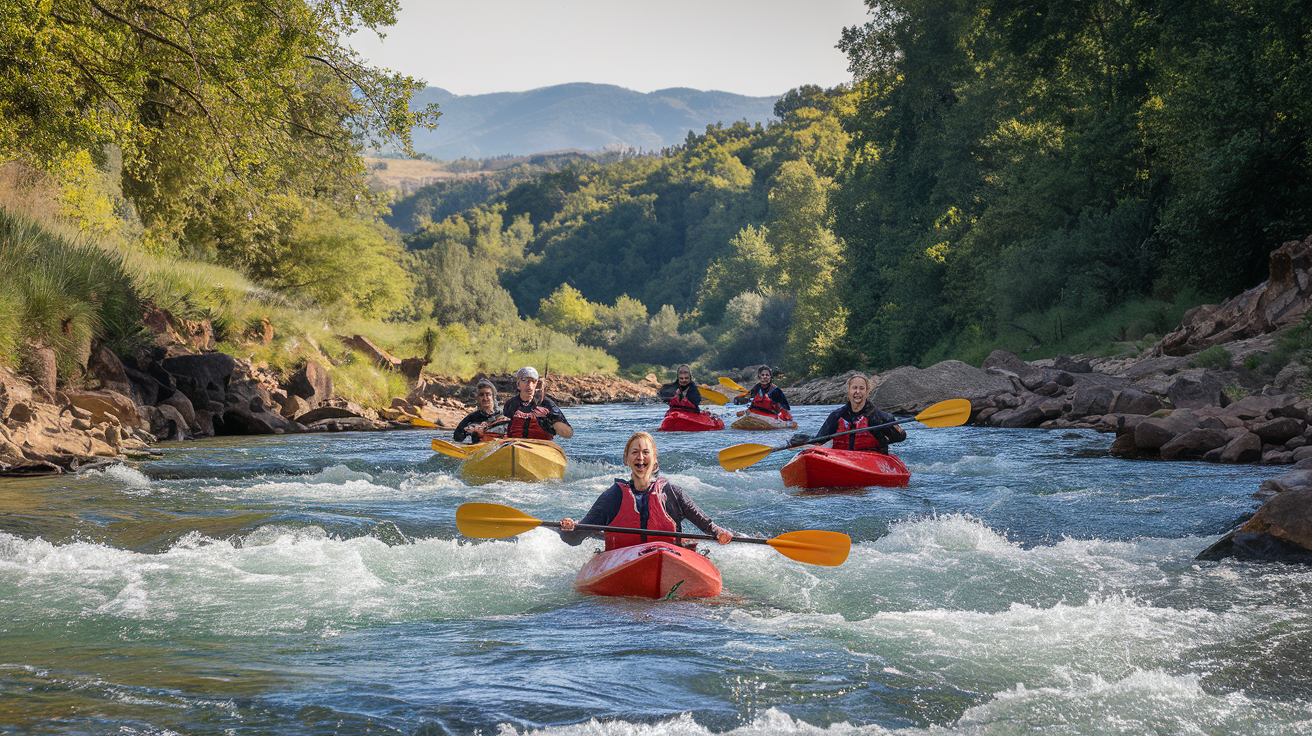
White Water Rafting on Paiva River
Portugal’s Paiva River doesn’t just flow – it rages, twists, and tumbles through some of the most spectacular scenery in Central Portugal. And trust me, there’s nothing quite like the rush of navigating those rapids with water splashing in your face and adrenaline pumping through your veins.
The Paiva offers class II to IV rapids, making it perfect for both nervous first-timers and seasoned rafters looking for a challenge. What makes this river special isn’t just the thrilling white water sections, but the incredible unspoiled nature surrounding you as you paddle.
Most rafting adventures here start near Arouca, about an hour from Porto. Local outfitters provide all the gear you’ll need – helmet, life jacket, wetsuit in cooler months, and expert guides who know every rock and eddy of this wild river.
The journey typically covers about 14 kilometers of pristine waterway, with the most exciting rapids concentrated in sections like “The Washing Machine” and “Devil’s Throat” (yeah, they named them that for a reason). Between the adrenaline-pumping stretches, you’ll float through calm pools where you can catch your breath and actually look up at the dense forests and dramatic rock formations towering above you.
Spring brings the most exciting conditions after the winter rains, with water levels high and rapids at their most challenging. Summer offers a more relaxed experience, perfect for families or those who prefer their adventure with slightly less screaming.
What really sets Paiva apart from other European rafting destinations is how untouched it feels. Unlike more commercialized rivers, you won’t see roads or buildings along most of the route – just pure, wild nature. The water itself is remarkably clean and clear, running through the UNESCO-recognized Arouca Geopark.
After your rafting adventure, you can extend your experience by hiking the famous Paiva Walkways – wooden pathways that cling to the river valley, offering spectacular views of the same rapids you conquered from a drier perspective.
Stand-Up Paddleboarding Through Montego Valley
If white water rafting sounds a bit too intense, paddleboarding through Montego Valley offers the perfect balance of adventure and tranquility. The Mondego River (known locally as Rio Mondego) is Portugal’s longest entirely Portuguese river, and its middle stretches provide an ideal playground for SUP enthusiasts.
The valley itself is a hidden gem that many international travelers miss. Starting near the historic city of Coimbra, the river winds through a landscape that shifts from rolling hills and vineyards to dramatic gorges. The water here moves at a gentler pace than the wild Paiva, making it accessible to paddlers of all skill levels.
What makes paddleboarding here special is the perspective. Standing upright on your board, you get a 360-degree view of the landscape that you just can’t match from a kayak or canoe. You’ll glide past ancient olive groves, traditional stone villages, and occasional riverside beaches where locals relax on hot summer days.
The best paddleboarding route runs from Penacova to Coimbra, a stretch of about 25 kilometers that can be broken into smaller sections depending on your energy level and time constraints. The river here alternates between glassy calm sections and very mild rapids that add just enough excitement without requiring technical skills.
Wildlife spotting becomes a highlight when you’re silently gliding on a paddleboard. Kingfishers dart across the water, herons wade in the shallows, and if you’re lucky, you might spot otters playing near the banks. In spring, wildflowers carpet the hillsides, creating a colorful backdrop for your adventure.
Several outfitters in the region offer guided SUP tours, including instruction for beginners. Many combine paddleboarding with wine tasting or visits to riverside quintas (traditional Portuguese estates), creating a perfect blend of active adventure and cultural immersion.
The climate here is milder than Portugal’s coast, with warm summers perfect for taking refreshing dips when you need to cool off. Spring and fall offer comfortable temperatures and fewer fellow paddlers, making those seasons ideal for a more solitary experience.
What’s particularly appealing about paddleboarding the Mondego is how you can tailor the experience to your own pace. Fancy a workout? Power through with strong strokes. Prefer to soak in the scenery? Just stand still and let the gentle current do the work while you snap photos of the limestone cliffs and historic bridges.
Canoeing Under Limestone Formations
For those who want something in between the adrenaline of white water rafting and the serenity of paddleboarding, canoeing beneath Central Portugal’s magnificent limestone formations offers the perfect middle ground.
The network of rivers around the Serras de Aire e Candeeiros Natural Park creates a paddler’s paradise unlike anywhere else in Europe. Here, millions of years of water erosion have carved the limestone into fantastical shapes, creating natural arches, caves, and grottos that you can explore from the unique vantage point of a canoe.
The Nabão River near Tomar offers some of the most accessible limestone canoeing experiences. As you paddle, the forest occasionally opens up to reveal dramatic white limestone cliffs that seem to glow in the Portuguese sunshine. What makes this route special is how the river occasionally narrows, guiding you through canyon-like passages where the rock walls tower overhead.
More adventurous paddlers should head to the Alviela River, which features sections where limestone caves have partially collapsed, creating natural tunnels that you can paddle through. The play of light and shadow as sunbeams filter through openings in the rock ceiling creates an almost mystical atmosphere. Just be sure to go with experienced guides who know which passages are safe to navigate.
The water in these limestone regions is exceptionally clear – a result of natural filtration through the porous rock. This clarity makes for an almost magical paddling experience, especially in the deeper pools where you can see straight to the bottom, sometimes 10 meters below your canoe.
Unlike some other European paddling destinations, Portugal’s limestone rivers remain relatively uncrowded, even in peak summer months. You’ll often find yourself alone with just the sound of your paddle dipping into the water and the occasional call of a peregrine falcon nesting in the cliffs above.
Local outfitters typically offer half-day and full-day trips, with the latter often including a picnic lunch featuring regional specialties like Serra da Estrela cheese, chouriço sausage, and local wines. These stops frequently happen at hidden beaches or rocky shelves that are inaccessible except by water.
The limestone environment creates some interesting microclimates, with unexpected bursts of vegetation clinging to the rocks. You’ll paddle past hanging gardens of ferns and mosses that thrive in the moisture-rich environment created by the interaction of water and stone.
What many visitors don’t realize is that these limestone formations are connected to an extensive underground cave system. While you can’t access most caves directly from your canoe, some tours combine paddling with short hikes to explore accessible caverns adorned with stalactites and stalagmites.
The best time for limestone canoeing is late spring through early fall, when water levels are manageable and temperatures comfortable. Winter can bring higher, faster flows that change the character of these rivers significantly, sometimes making them too challenging for recreational paddlers.
Birdwatching in Portugal’s Wetland Reserves
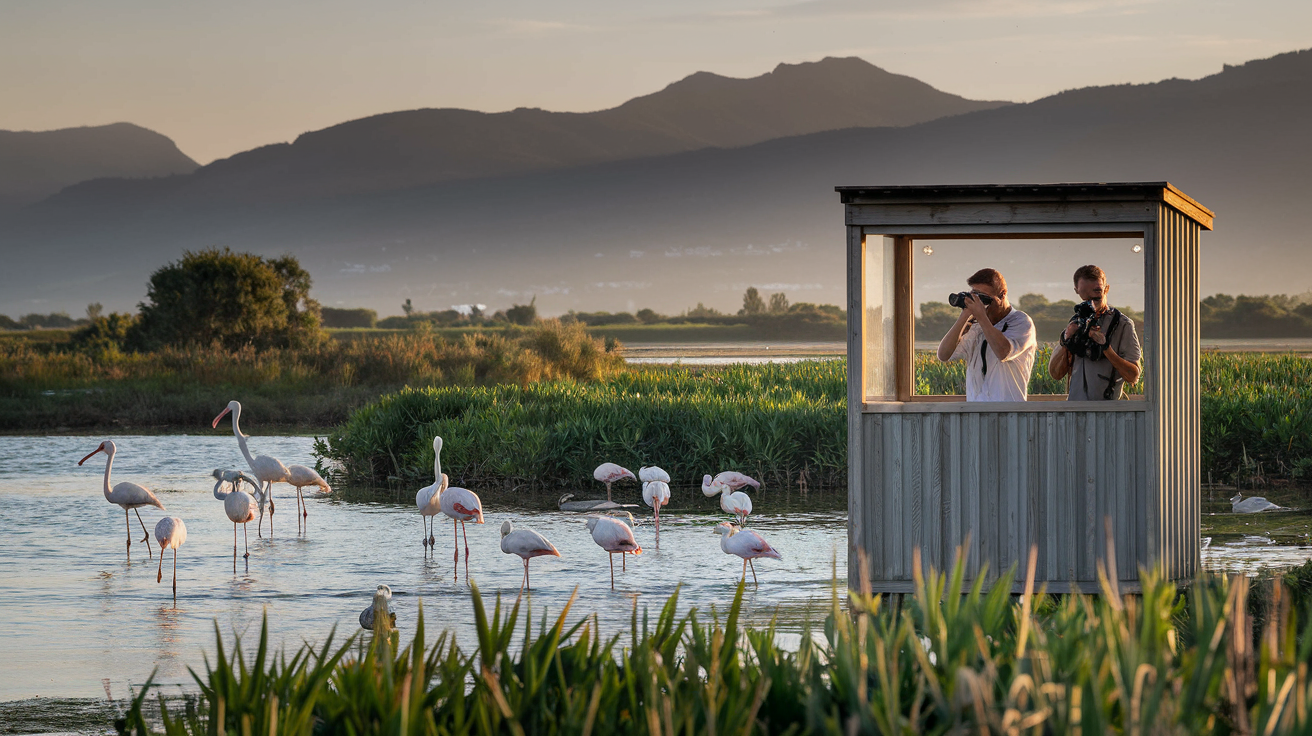
Spotting Flamingos in Ria Formosa
Portugal’s Ria Formosa Natural Park isn’t just another wetland – it’s flamingo paradise. This stunning lagoon system stretches across 60 kilometers of the Algarve coastline, creating one of Europe’s most important habitats for these iconic pink birds.
The first time you spot a flock of flamingos here, it’s almost surreal. Their vibrant pink feathers create a striking contrast against the blue-green waters and golden sands. These magnificent birds aren’t year-round residents, but you’ll find them in greatest numbers between October and March when they migrate here for the winter months.
What makes Ria Formosa so perfect for flamingo watching? It’s all about the food. The shallow, nutrient-rich waters are packed with small crustaceans, algae, and other tiny organisms that flamingos love to filter-feed on. This diet is actually what gives them their distinctive pink coloration!
The best spots for flamingo watching include the areas near Faro, Olhão and Tavira. Early morning or late afternoon provide optimal lighting conditions for both viewing and photography. Bring binoculars if you have them – while flamingos sometimes feed close to observation points, they often prefer keeping a comfortable distance from humans.
Boat tours offer an incredible way to get closer to these magnificent birds without disturbing them. Local guides know exactly where the flamingos tend to gather and can position you perfectly for observation without causing any stress to the birds.
The flamingos aren’t alone here either. While watching these pink beauties, you might spot spoonbills, avocets, and numerous other wading birds sharing the same productive feeding grounds. It’s a birdwatcher’s dream come true.
Photographing Rare Species in Tagus Estuary
Just minutes from Lisbon’s bustling streets lies a birdwatcher’s paradise that many travelers completely miss. The Tagus Estuary Natural Reserve covers roughly 14,000 hectares of wetlands, creating Portugal’s largest estuary and a critical stopover point on the East Atlantic Flyway migration route.
This massive wetland hosts over 250 bird species throughout the year, making it one of Europe’s most diverse bird habitats. What’s truly incredible is the rare species you can photograph here – birds that serious wildlife photographers travel thousands of miles to capture.
The black-winged stilt is a favorite subject, with its impossibly long red legs and striking black-and-white plumage. These elegant waders can be spotted year-round but are particularly photogenic during breeding season when they perform elaborate courtship displays.
Then there’s the glossy ibis, once extremely rare in Portugal but now establishing breeding colonies in the estuary. Their dark feathers shimmer with an iridescent green-purple sheen in good light, creating stunning photographic opportunities at dawn and dusk.
The Tagus Estuary is also one of the few places in Europe where you might photograph the purple swamphen – a chicken-sized water bird with vibrant blue-purple plumage and an almost prehistoric-looking red bill and forehead shield. They’re shy birds but can be photographed from the many bird hides scattered throughout the reserve.
For photographers, timing is everything here. The magic hours around sunrise and sunset not only provide the best light but also coincide with periods of peak bird activity. Winter brings the highest concentration of birds, with tens of thousands of waders, ducks and other waterbirds creating spectacular scenes.
The EVOA (Espaço de Visitação e Observação de Aves) visitor center near Alcochete offers three artificial freshwater lagoons with perfectly positioned hides for photography. The main hide has large windows at different heights, making it suitable for photographers of all heights and abilities, including wheelchair users.
Don’t forget specialized equipment if you have it. A telephoto lens (at least 300mm, preferably longer) is essential for bird photography here. A tripod helps with stability, especially in the low light conditions of early morning. Waterproof gear is also recommended – both for you and your equipment – as the weather can change quickly.
What makes the Tagus Estuary truly special for wildlife photographers is the combination of exceptional biodiversity and accessibility. Unlike many prime bird photography locations, you don’t need to trek through difficult terrain or spend days in uncomfortable blinds. Most photography spots are accessible by car or short walks, making this an ideal location even for beginners.
Guided Tours Through Castro Verde Plains
The Castro Verde Plains stretch across Portugal’s southern Alentejo region, offering a completely different birdwatching experience from the country’s coastal wetlands. This vast steppe landscape, with its rolling golden grasslands and scattered cork oak trees, harbors some of Europe’s most endangered bird species.
What makes Castro Verde truly special is that you can’t really experience it properly without a guide. The birds here are specialists adapted to these open plains, and many are masters of camouflage or extremely wary of human presence. A good guide doesn’t just know where to find them – they understand how to approach without causing disturbance.
The crown jewel of Castro Verde is undoubtedly the great bustard. These massive birds – males can weigh up to 18kg, making them one of the world’s heaviest flying birds – perform spectacular breeding displays each spring. Watching a male bustard inflate its neck, turn its feathers inside out to reveal white plumage, and strut around like a feathered battleship is an unforgettable wildlife experience.
Another steppe specialist you’ll search for is the little bustard. Despite its name, there’s nothing “little” about the male’s breeding display, when it jumps into the air making a distinctive “prrt” sound that carries across the plains. Your guide will likely recognize this sound long before you spot the bird.
The LPN (Liga para a Proteção da Natureza) runs the excellent Centro de Educação Ambiental do Vale Gonçalinho, which serves as the starting point for many guided tours. Their guides are passionate conservationists who’ve dedicated years to studying and protecting these birds.
Most tours start early – really early. Being on the plains at dawn increases your chances of seeing bustards and other shy species before they retreat from the day’s heat. The golden morning light also transforms the landscape, creating perfect conditions for both observation and photography.
Spring tours (March-May) focus on breeding displays and migrants, while autumn brings different specialties including Spanish imperial eagles that hunt over the plains. Winter tours offer chances to see large flocks of cranes that migrate here from northern Europe.
Beyond birds, guides will introduce you to the region’s unique cultural heritage. The Castro Verde plains represent one of Europe’s oldest agricultural landscapes, with farming practices dating back thousands of years. This traditional low-intensity agriculture created the perfect habitat for steppe birds, and understanding this relationship is key to appreciating the conservation efforts underway.
Tour operators typically offer half-day or full-day excursions, with the latter providing more comprehensive coverage of different habitats within the region. Full-day tours often include visits to nearby reservoirs where you might spot black-winged kites hunting over the water or Bonelli’s eagles soaring overhead.
What participants consistently praise about these guided experiences is how they transform the seemingly empty landscape into a living ecosystem full of fascinating stories. Birds that were invisible to the untrained eye suddenly appear everywhere once you know what to look for. The plains come alive through your guide’s interpretation, revealing the complex web of relationships between plants, insects, birds, and human activities.
Sustainable Eco-Adventures

A. Volunteer Conservation Programs in Protected Areas
Portugal’s natural beauty isn’t just for admiring—it’s for protecting too. The country offers incredible opportunities to roll up your sleeves and make a real difference through conservation programs.
Take the Serra da Estrela Natural Park, where volunteers help maintain hiking trails, monitor wildlife populations, and assist in reforestation projects. You’ll work alongside dedicated conservationists who know these mountains like the back of their hand.
The Ria Formosa Natural Park in the Algarve runs seasonal programs where you can participate in coastal cleanup efforts and help protect endangered species like the Portuguese water dog and seahorses. Nothing beats the feeling of knowing those pristine beaches stay pristine because of your work.
In the north, the Peneda-Gerês National Park—Portugal’s only national park—welcomes volunteers to assist with wolf conservation efforts. You might help install wildlife cameras, collect data on wolf movements, or educate locals about coexistence with these magnificent creatures.
These programs typically run from a weekend to several weeks, depending on your availability. Most provide basic accommodation, sometimes in rustic ranger cabins or eco-friendly lodges within the parks themselves.
What makes these volunteer opportunities special is their hands-on approach. You won’t just be donating money to conservation—you’ll be actively participating in it, learning specialized skills from experts, and seeing the direct impact of your work.
Many visitors say these experiences changed how they view their relationship with nature. There’s something profoundly satisfying about leaving a place better than you found it, especially one as beautiful as Portugal’s protected areas.
B. Foraging Tours with Local Experts
Portugal’s countryside is a natural pantry bursting with edible treasures—if you know where to look. Foraging tours have become increasingly popular as visitors seek deeper connections to Portuguese landscapes and culinary traditions.
In the Douro Valley, expert guides lead groups through ancient olive groves and forests to collect wild asparagus, mushrooms, and aromatic herbs that have seasoned Portuguese dishes for centuries. The experience is sensory overload—the earthy smell of fresh fungi, the texture of wild thyme between your fingers, the snap of finding a perfectly ripe berry.
The Alentejo region, often called Portugal’s breadbasket, offers particularly rich foraging opportunities. Here, guides teach you to identify carob, wild fennel, and countless varieties of edible flowers. Most tours conclude with an impromptu field-to-table meal where you’ll help prepare what you’ve gathered, paired with local wines.
During autumn in central Portugal, mushroom foraging becomes almost a national obsession. Expert mycologists lead expeditions to find prized porcini and chanterelles hidden among pine forests. They’ll teach you not just identification skills but also sustainable harvesting practices to ensure these delicacies return year after year.
Coastal foraging tours focus on seaweed varieties, samphire, and other salt-tolerant edibles that thrive along Portugal’s rugged Atlantic shores. Nothing compares to the taste of sea vegetables harvested minutes before eating—briny, mineral-rich, and bursting with umami flavors you simply can’t find in stores.
These tours do more than just fill your basket—they connect you to Portuguese cultural heritage. Many guides come from families who’ve passed down foraging knowledge through generations, preserving traditional ecological wisdom that predates modern agriculture.
Safety always comes first—reputable guides emphasize proper identification techniques and teach you to forage respectfully, taking only what you need and leaving plenty for wildlife and plant regeneration. You’ll learn which look-alike plants to avoid and how to minimize your impact on these delicate ecosystems.
C. Dark Sky Stargazing in Alqueva
The Alqueva region in Portugal’s Alentejo holds a title few places on earth can claim—it’s home to the world’s first “Starlight Tourism Destination.” This isn’t just marketing hype. The skies above Alqueva are mind-blowingly dark, free from the light pollution that blankets most of Europe.
This astronomical wonderland spans about 3,000 square kilometers and encompasses several municipalities around the Great Lake of Alqueva. The area’s dry climate, clear air, and sparse population create perfect conditions for stargazing over 300 nights a year.
What makes Alqueva truly special is how accessible its cosmic wonders are. You don’t need to be an astronomy expert to appreciate the night sky here. Local companies offer guided stargazing experiences where powerful telescopes reveal Saturn’s rings, Jupiter’s moons, and distant galaxies that appear as mere smudges to the naked eye.
For photography enthusiasts, nighttime workshops teach the techniques for capturing stunning images of the Milky Way as it arches over ancient dolmens, whitewashed villages, and the calm waters of the lake. The contrast between these earthly structures and the infinite cosmos creates photos that look almost surreal.
Families particularly love the “astro-picnics” organized during summer months, where local astronomers set up telescopes in scenic spots while you enjoy traditional Alentejo cuisine under the stars. Kids go wild when they see the moon’s craters or catch their first shooting star.
The experience changes with the seasons too. Summer brings the dense star clouds of the Milky Way core, while winter offers crisp views of Orion and the Pleiades. During meteor showers like the Perseids in August, locals and visitors alike gather for overnight watching parties that feel like a cosmic celebration.
What’s remarkable about this form of eco-adventure is its minimal environmental impact. Stargazing requires no special infrastructure beyond maintaining the dark sky itself—a resource that benefits local wildlife and human wellbeing alike.
D. Wildlife Photography Expeditions
Portugal packs remarkable biodiversity into its relatively small territory, making it a paradise for wildlife photographers. From soaring birds of prey to elusive Iberian lynx, the country offers photographic opportunities that rival more famous safari destinations.
In the estuaries and wetlands of the Tagus and Sado rivers, photography hides allow for close observation of flamingos, spoonbills, and countless migratory birds without disturbing their natural behaviors. The golden light of early morning turns these wetlands into living watercolor paintings as birds take flight in massive, coordinated movements.
The Côa Valley in northeastern Portugal specializes in expeditions focused on capturing images of wild Iberian wolves—one of Europe’s most endangered and elusive predators. Expert trackers know the pack territories intimately and can position photographers in spots where wolves are likely to appear at dawn or dusk. Even if the wolves don’t make an appearance, the valley’s dramatic landscapes and rich bird life ensure your memory cards won’t return empty.
Marine wildlife expeditions depart from the Algarve and Azores, focusing on dolphins, whales, and seabirds. The Azores in particular offer world-class opportunities to photograph sperm whales and several dolphin species in crystal-clear Atlantic waters. Responsible operators use boats with specialized engines that minimize disturbance to marine life.
What makes Portugal’s wildlife photography expeditions stand out is their educational component. Guides don’t just lead you to animals—they explain ecosystem relationships, conservation challenges, and the behaviors you’re witnessing. Many trips incorporate talks by researchers actively studying these species, giving photographers insight into the science behind the shots.
Technical support varies by operator, but many provide specialized guidance on camera settings, lighting challenges, and composition techniques specific to wildlife photography. Some even offer portable blinds, tripods, and lens rentals for travelers who don’t want to transport heavy equipment.
These expeditions practice strict ethical standards—no baiting animals, maintaining safe distances, and limiting group sizes to minimize environmental impact. The best operators contribute a portion of their proceeds directly to conservation efforts protecting the very species they showcase.
Ultimately, wildlife photography in Portugal offers more than just stunning images. It creates advocates for conservation. When you’ve spent hours waiting for the perfect shot of an Iberian lynx or a soaring eagle, you develop a personal connection to these creatures and the wild places they need to survive.
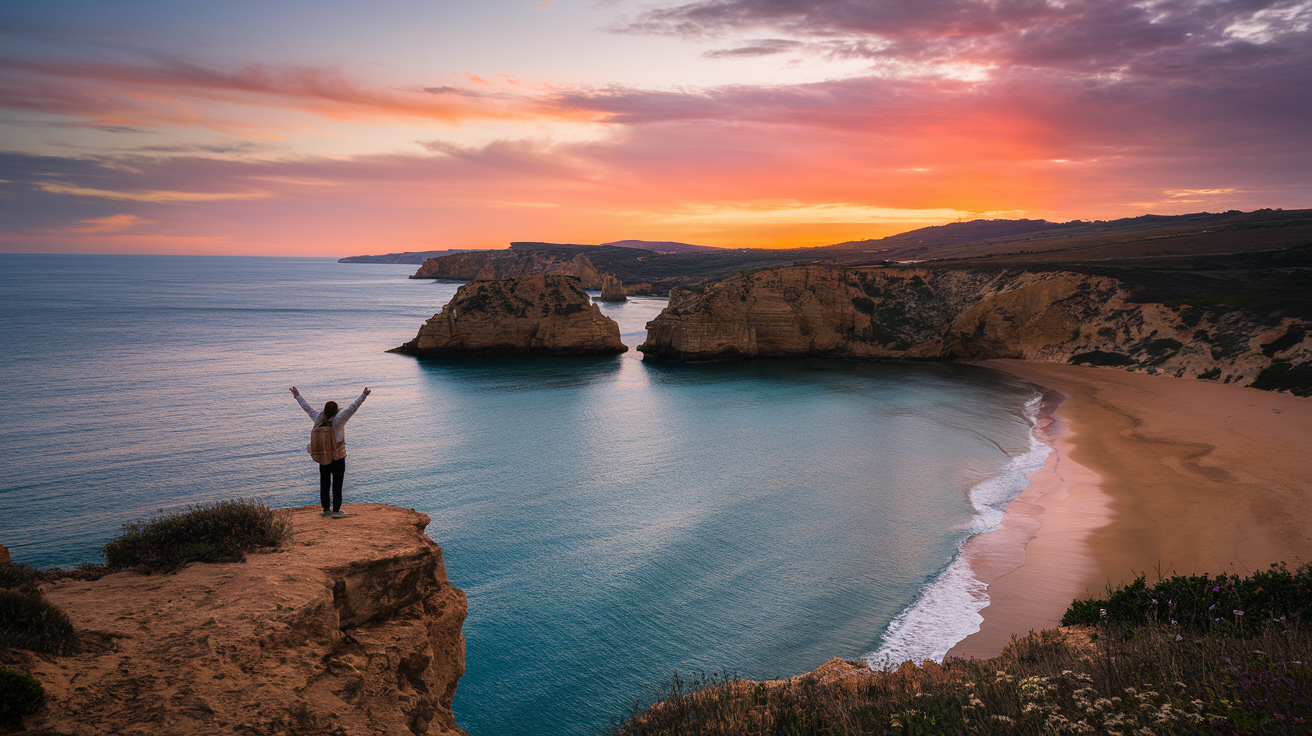
From dramatic coastlines to volcanic archipelagos, Portugal offers an astonishing variety of natural landscapes waiting to be explored. Whether you’re hiking through the rugged mountains of Serra da Estrela, kayaking along the Douro Valley’s vineyard-lined shores, or discovering the underground wonders of Portugal’s cave systems, this compact European nation delivers outdoor adventures that rival destinations twice its size. The diversity of experiences—from wild camping in Peneda-Gerês to birdwatching in protected wetlands—ensures there’s something for every type of nature enthusiast.
As you plan your Portuguese adventure, remember that responsible tourism practices are essential to preserving these natural wonders for future generations. The country’s commitment to sustainable eco-adventures makes it possible to experience its breathtaking landscapes while minimizing your environmental impact. Pack your hiking boots, grab your camera, and prepare for an unforgettable journey through Portugal’s most spectacular outdoor destinations—where ancient traditions and natural beauty create the perfect backdrop for adventure.


